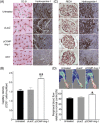Angiopoietin-1 prevents hypertension and target organ damage through its interaction with endothelial Tie2 receptor
- PMID: 18285514
- PMCID: PMC5436684
- DOI: 10.1093/cvr/cvn048
Angiopoietin-1 prevents hypertension and target organ damage through its interaction with endothelial Tie2 receptor
Erratum in
- Cardiovasc Res. 2008 Nov 1;80(2):319
Abstract
Aims: The endothelium has emerged recently as a therapeutic target in the treatment of hypertension because endothelial dysfunction and subsequent vascular rarefaction cause target organ damage and further elevate blood pressure (BP). It led us to hypothesize that one of the endothelial survival factors, a potent derivative of angiopoietin-1 (cartilage oligomeric matrix protein, COMP-Ang-1), could be a novel class of antihypertensive agents that maintain endothelial integrity and function, thereby preventing the development of hypertension and target organ damage.
Methods and results: To study the role of COMP-Ang-1 in preventing hypertension and target organ damage, a COMP-Ang-1 plasmid was electroporated into adductor muscles of 6 weeks old, pre-hypertensive, spontaneously hypertensive rats (SHRs), and the secretion of its expressed protein into the bloodstream was confirmed by western blotting. In comparison with sham and reporter gene transfer, COMP-Ang-1 gene transfer significantly prevented increases in systolic BP and reduced microvascular rarefaction and tissue damage in the heart and kidney. However, overexpression of soluble Tie2 receptor completely abolished these beneficial effects of COMP-Ang-1 gene transfer on SHRs, indicating that expressed COMP-Ang-1 protein has antihypertensive effects in SHRs by binding Tie2 receptors on the vascular endothelium. In particular, COMP-Ang-1 gene-transferred SHRs had significantly higher plasma levels of nitrite than other controls, which was found to be due to that expressed COMP-Ang-1 protein promoted nitrite synthesis by activating endothelial nitric oxide synthase, one of the Tie2 downstream-signalling molecules.
Conclusion: The present study suggests a new potential of endothelial survival factor, COMP-Ang-1, as an antihypertensive agent that effectively reduces the hypertension-associated cardiovascular and renal damage, as well as prevents the further elevation of BP.
Figures






Similar articles
-
Angiopoietin-1 gene therapy attenuates hypertension and target organ damage in nitric oxide synthase inhibited spontaneously hypertensive rats.Korean Circ J. 2011 Oct;41(10):590-5. doi: 10.4070/kcj.2011.41.10.590. Epub 2011 Oct 31. Korean Circ J. 2011. PMID: 22125558 Free PMC article.
-
Angiopoietins regulate vascular reactivity after haemorrhagic shock in rats through the Tie2-nitric oxide pathway.Cardiovasc Res. 2012 Nov 1;96(2):308-19. doi: 10.1093/cvr/cvs254. Epub 2012 Aug 6. Cardiovasc Res. 2012. PMID: 22869617
-
Vascular protective effects of aqueous extracts of Tribulus terrestris on hypertensive endothelial injury.Chin J Nat Med. 2017 Aug;15(8):606-614. doi: 10.1016/S1875-5364(17)30088-2. Chin J Nat Med. 2017. PMID: 28939023
-
Intra and extravascular transmembrane signalling of angiopoietin-1-Tie2 receptor in health and disease.J Cell Mol Med. 2008 Jun;12(3):810-28. doi: 10.1111/j.1582-4934.2008.00254.x. Epub 2008 Feb 4. J Cell Mol Med. 2008. PMID: 18266978 Free PMC article. Review.
-
COMP-Ang1: Therapeutic potential of an engineered Angiopoietin-1 variant.Vascul Pharmacol. 2021 Dec;141:106919. doi: 10.1016/j.vph.2021.106919. Epub 2021 Sep 25. Vascul Pharmacol. 2021. PMID: 34583025 Review.
Cited by
-
Novel Targets for Hypertension Drug Discovery.Curr Hypertens Rep. 2021 Mar 30;23(4):19. doi: 10.1007/s11906-021-01137-6. Curr Hypertens Rep. 2021. PMID: 33783647 Review.
-
Hypertension, vascular rarefaction and angiopoietin-1.Korean Circ J. 2011 Oct;41(10):575-7. doi: 10.4070/kcj.2011.41.10.575. Epub 2011 Oct 31. Korean Circ J. 2011. PMID: 22125555 Free PMC article. No abstract available.
-
Angiopoietin-1 gene therapy attenuates hypertension and target organ damage in nitric oxide synthase inhibited spontaneously hypertensive rats.Korean Circ J. 2011 Oct;41(10):590-5. doi: 10.4070/kcj.2011.41.10.590. Epub 2011 Oct 31. Korean Circ J. 2011. PMID: 22125558 Free PMC article.
-
Soluble vascular endothelial growth factor decoy receptor FP3 exerts potent antiangiogenic effects.Mol Ther. 2012 May;20(5):938-47. doi: 10.1038/mt.2011.285. Epub 2012 Jan 24. Mol Ther. 2012. PMID: 22273580 Free PMC article.
-
Clinical significance of Angiopoietin-1 in Behcet's disease patients with vascular involvement.Heart Vessels. 2016 Jun;31(6):918-24. doi: 10.1007/s00380-015-0686-9. Epub 2015 May 12. Heart Vessels. 2016. PMID: 25964071
References
-
- Cohuet G, Struijker-Boudier H. Mechanisms of target organ damage caused by hypertension: therapeutic potential. Pharmacol Ther. 2006;111:81–98. - PubMed
-
- Redon J. Antihypertensive treatment: should it be titrated to blood pressure reduction or to target organ damage regression? Curr Opin Nephrol Hypertens. 2005;14:448–452. - PubMed
-
- Grimm RH, Jr, Flack JM, Byington R, Bond G, Brugger S. A comparison of antihypertensive drug effects on the progression of extracranial carotid atherosclerosis. The Multicenter Isradipine Diuretic Atherosclerosis Study (MIDAS) Drugs. 1990;40(Suppl. 2):38–43. - PubMed
-
- Samuelsson OG, Wilhelmsen LW, Svardsudd KF, Pennert KM, Wedel H, Berglund GL. Mortality and morbidity in relation to systolic blood pressure in two populations with different management of hypertension: The Study of Men Born in 1913 and the Multifactorial Primary Prevention Trial. J Hypertens. 1987;5:57–66. - PubMed
-
- Levy BI, Ambrosio G, Pries AR, Struijker-Boudier HA. Microcirculation in hypertension: a new target for treatment? Circulation. 2001;104:735–740. - PubMed
Publication types
MeSH terms
Substances
LinkOut - more resources
Full Text Sources
Medical
Miscellaneous

